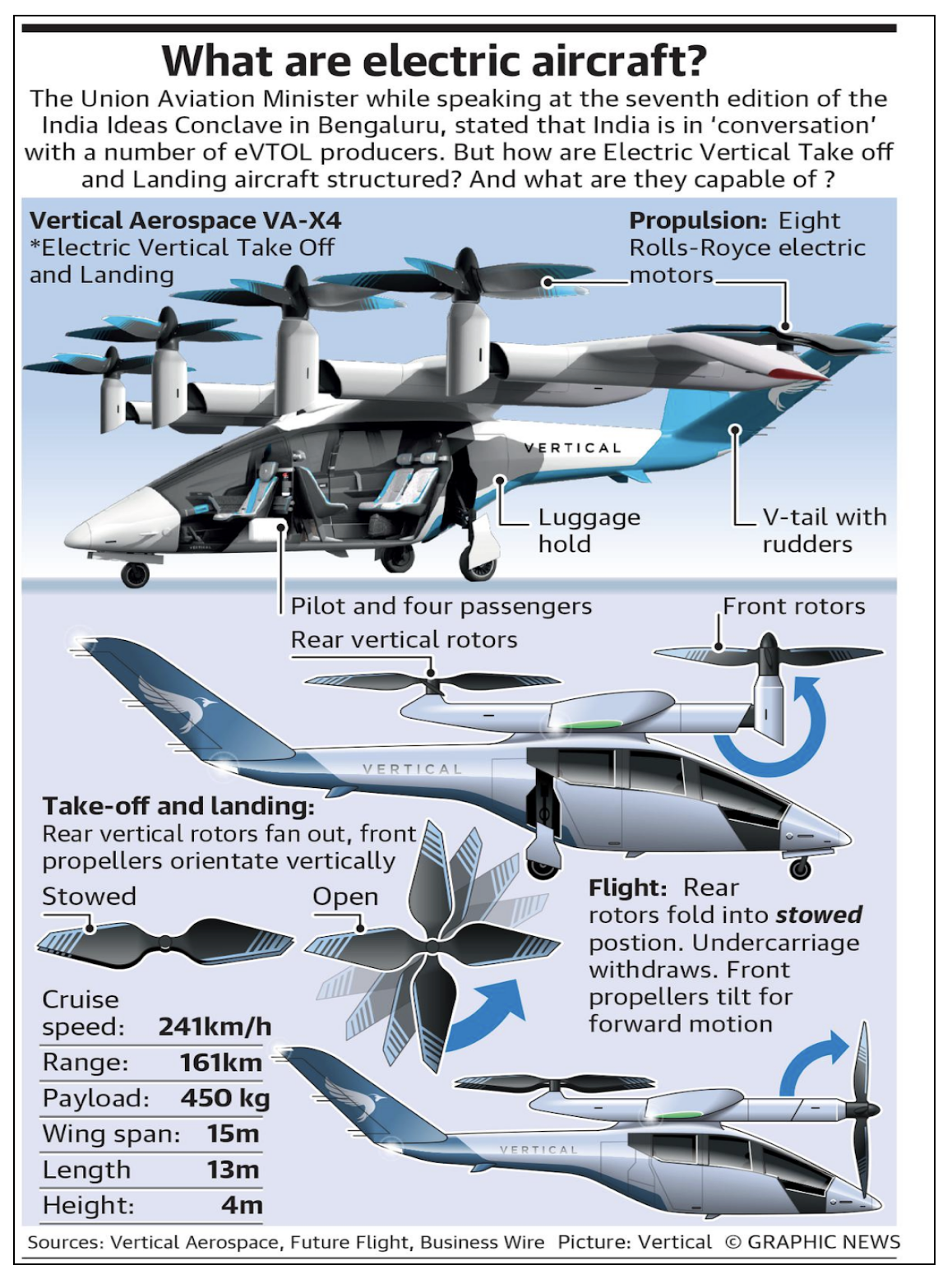GS Paper III
News Excerpt:
The advancements in eVTOL technology indeed hold tremendous promise for revolutionizing urban transportation and emergency services globally.
More About the News:
- Imagine a taxi that utilizes electric power to soar through the skies at speeds of up to 200 kilometers per hour, capable of vertical takeoff, hovering, and landing without the need for a traditional helipad.
- This futuristic vehicle, known as an electric vertical takeoff and landing aircraft (eVTOL), offers the promise of efficient urban air mobility without the high fuel and maintenance costs associated with conventional helicopters.
- The potential benefits in terms of reducing congestion, lowering emissions, and providing quicker access to critical services like medical care are truly remarkable.
About eVTOL:
eVTOL, or Electric Vertical Takeoff and Landing aircraft, represent a significant advancement in aviation technology.
- Technology Overview: eVTOLs utilize electric power for propulsion, enabling them to hover, take off, and land vertically without the need for traditional combustion engines.
- This technology involves integrating multiple electric motors throughout the aircraft's airframe, enhancing efficiency, maneuverability, and safety.
- High-energy-density batteries power eVTOLs, providing the necessary electrical energy for flight. Many eVTOLs incorporate sensors, cameras, and radar for autonomous operation, enabling connectivity and enhancing safety.
- Design Variations: eVTOL designs vary widely, including multi-rotor configurations, fixed-wing designs, and tilt-wing configurations. Each design offers unique advantages and trade-offs in terms of efficiency, payload capacity, range, and operational flexibility.
Advantages:
- Congestion Alleviation: eVTOLs offer a promising solution to urban traffic congestion by providing a vertical alternative to ground transportation.
- Direct Travel: Their ability to take off and land vertically enables more direct travel routes, potentially reducing overall travel times.
- Accessibility: eVTOLs could extend air travel access to remote or inaccessible areas, enhancing connectivity.
- Environmental Friendliness: With zero direct emissions, eVTOLs present a greener alternative to traditional fossil fuel-powered aircraft, contributing to environmental sustainability.
- Noise Reduction: Their quiet operation mitigates noise pollution, especially in urban environments, enhancing public acceptance.
- Cost Efficiency: Lower operating and maintenance costs, coupled with simpler mechanics, make eVTOLs economically attractive compared to conventional aircraft.
- Versatile Infrastructure: eVTOLs can operate from various open areas, eliminating the need for dedicated infrastructure like airports or helipads.
- Emergency Response: eVTOLs can serve as rapid responders in emergency situations, bypassing ground traffic and reaching affected areas more efficiently.
Challenges:
- Safety: Ensuring crash prevention systems and addressing concerns related to powerplant or rotor failure are critical for safe eVTOL operations.
- Cybersecurity: Protecting eVTOLs from cyberattacks is essential to safeguard their operation and data integrity.
- Navigation and Flight Safety: Operating eVTOLs in challenging terrain, adverse weather conditions, and unsafe environments requires robust navigation systems and flight safety protocols.
Implementation of eVTOL in India:
- Regulatory Framework: There is a need for regulatory authorities in India to formulate regulations specifically for eVTOLs and pilotless vehicles, including airworthiness certifications and requirements for pilot's licenses.
- Technology Integration: Implementing efficient energy management systems, onboard sensors, collision detection systems, and advanced technologies like artificial intelligence will be crucial for safe eVTOL operations.
- Infrastructure Development: Infrastructural support such as take-off and landing zones, parking lots, charging stations, and dedicated vertiports will need to be established.
- Air Traffic Management: A robust air traffic management system that integrates eVTOLs with other modes of transportation will be required.
- Safety Standards: A comprehensive document outlining compliance and safety standards for eVTOLs, aligned with commercial aviation standards, needs to be developed.
- Certification Timeline: The current timeline for certification with India's Directorate General of Civil Aviation is estimated to be around two years.
- Public Acceptance: Psychological barriers and concerns related to flying in fully autonomous aircraft will need to be addressed to ensure public acceptance.



